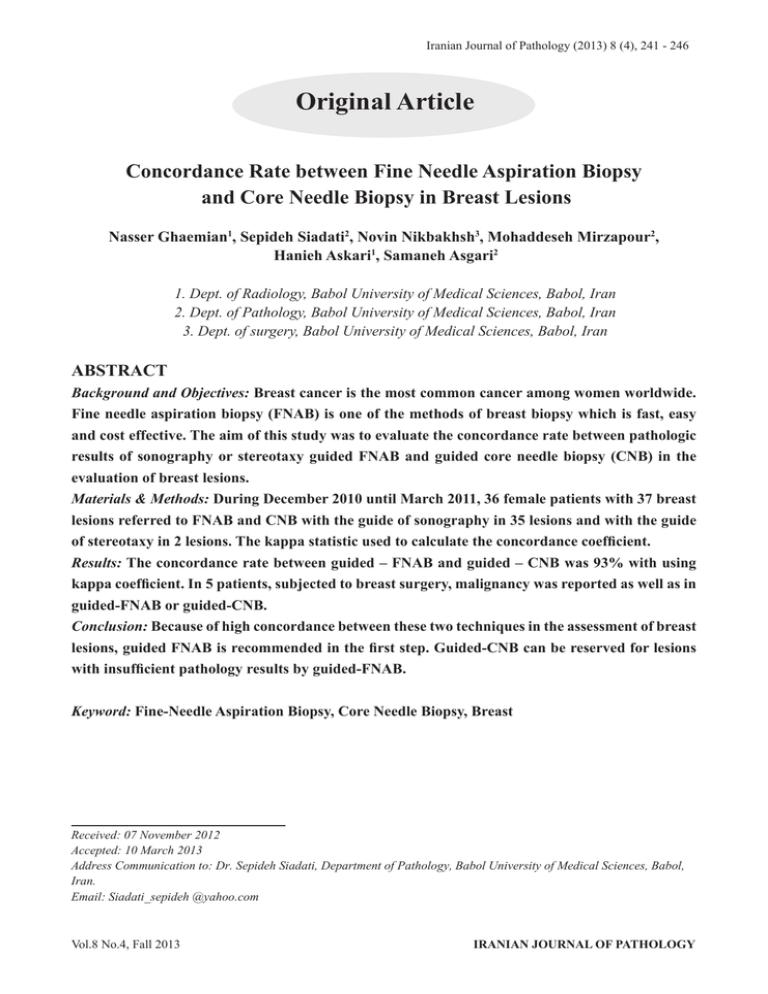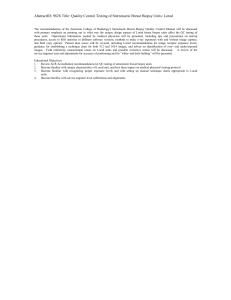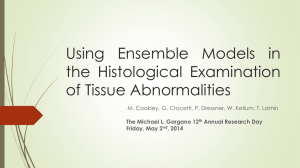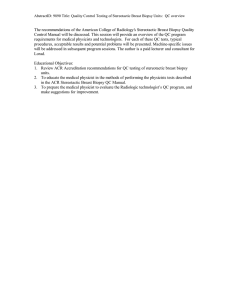- Iranian Journal of Pathology
advertisement

241 Iranian Journal of Pathology (2013) 8 (4), 241 - 246 Original Article Concordance Rate between Fine Needle Aspiration Biopsy and Core Needle Biopsy in Breast Lesions Nasser Ghaemian1, Sepideh Siadati2, Novin Nikbakhsh3, Mohaddeseh Mirzapour2, Hanieh Askari1, Samaneh Asgari2 1. Dept. of Radiology, Babol University of Medical Sciences, Babol, Iran 2. Dept. of Pathology, Babol University of Medical Sciences, Babol, Iran 3. Dept. of surgery, Babol University of Medical Sciences, Babol, Iran ABSTRACT Background and Objectives: Breast cancer is the most common cancer among women worldwide. Fine needle aspiration biopsy (FNAB) is one of the methods of breast biopsy which is fast, easy and cost effective. The aim of this study was to evaluate the concordance rate between pathologic results of sonography or stereotaxy guided FNAB and guided core needle biopsy (CNB) in the evaluation of breast lesions. Materials & Methods: During December 2010 until March 2011, 36 female patients with 37 breast lesions referred to FNAB and CNB with the guide of sonography in 35 lesions and with the guide of stereotaxy in 2 lesions. The kappa statistic used to calculate the concordance coefficient. Results: The concordance rate between guided – FNAB and guided – CNB was 93% with using kappa coefficient. In 5 patients, subjected to breast surgery, malignancy was reported as well as in guided-FNAB or guided-CNB. Conclusion: Because of high concordance between these two techniques in the assessment of breast lesions, guided FNAB is recommended in the first step. Guided-CNB can be reserved for lesions with insufficient pathology results by guided-FNAB. Keyword: Fine-Needle Aspiration Biopsy, Core Needle Biopsy, Breast Received: 07 November 2012 Accepted: 10 March 2013 Address Communication to: Dr. Sepideh Siadati, Department of Pathology, Babol University of Medical Sciences, Babol, Iran. Email: Siadati_sepideh @yahoo.com Vol.8 No.4, Fall 2013 IRANIAN JOURNAL OF PATHOLOGY 242 Concordance Rate between Fine Needle Aspiration Biopsy and ... B Introduction reast carcinoma is the most common malignant tumor among women worldwide including Iranian women (1-5). It is the second cause of cancer related death among women in the world. Approximately onequarter of all patients who diagnosed breast cancer die from this disease (6-8). Despite increasing incidence the annual death rate especially in recent years dropped(1.8% annually from 1998 to 2007) because of screening, early diagnosis and appropriate treatment (9). For this reason several measures have been taken to provide cancer detection, such as fine needle aspiration biopsy (FNAB). This technique is cost effective; less invasive, more easily done and still have fewer side effects. FNAB is an easy outpatient diagnostic method for evaluation of breast mass especially in experienced hands. For biopsy of a mass we can locate it manually or with guidance of ultrasonography or stereotaxy. In FNAB a very thin and flexible needle with a narrow inner core used to extract fluid or cells from the lesion. This method has some limitations as well: its inability to differentiate between invasive and in situ carcinoma, insufficient samples and false negative results (10 – 16). Another method of breast mass biopsy is core needle biopsy (CNB) done with a larger needle than used in FNAB to remove tissue sample. Sonographic or stereotactic guided CNB used for all palpable or non- palpable breast mass to increase the accuracy of biopsy. The advantages of CNB are lower inadequate rates, allow the ancillary methods, grading and typing of tumor (in cases of cancer). However, it is more invasive, time – consuming and more expensive (10, 11, 16-20). Now “Triple assessment”, including physical examination, imaging and biopsy is accepted as a method for early detection of cancer (12-18, 21). As already mentioned, FNAB is faster, more cost effective, safer and easier to perform than other IRANIAN JOURNAL OF PATHOLOGY methods. Therefore, this study was designed to determine the concordance between pathologic results of FNAB and CNB. Materials and Methods This study was done on patients referred to radiologist for the breast mass biopsy from December 2010 to March 2011. The study was approved by Babol University of Medical Sciences Ethics Committee. From all women that had indication for CNB informed consent for FNAB was obtained. Both CNB and FNAB were done by two guided methods, sonography or streotaxy. Sonography guided biopsy performed for all patients with palpable or visible mass on sonography and stereotaxy guided biopsy was done for sonography invisible mass. Sonography and srereotaxy equipments were G.E.logic 700 with 9-13 MHz linear transducer and simensmammo mat3, respectively. Two craniocaudal views were taken to determine the location of lesion and needle. FNAB was done under local anesthesia. Enough material (4-6 slides) was obtained by fine needle (22-23 G) from lesion and margins. Half of these slides were air – dried and the others were carnoy’s – fixed. Then guided – CNB was performed by 14 or 16 G needle. All slides sent to pathology departments, were stained by conventional methods and examined by pathologist. All cytology slides examined without any knowledge about biopsy results and classified as follows: 1. C1: Unsatisfactory 2.C2 : Benign 3.C3: Atypia probably benign 4.C4: Suspicious for malignancy 5.C5: Malignant (17). Kappa measure of concordance was calculated and reported based on the percentage. Landis and Vol.8 No.4, Fall 2013 Nasser Ghaemian, et al. 243 Koch’s guidelines have been used to interprete K levels. According to these strategy K coefficient less than 0 indicating no agreement, 0-0.2 as slight, 0.21 – 4 as fair, 0.41 – 0.6 as moderate, 0.61 – 0.8 as substantial, and 0.8 -1 as almost perfect agreement (22). diagnosed as cyst (5 cases) and lipoma (2 cases) placing the report in benign (C2) category. Therefore, the results were separated into 2 groups, benign (C1, C2 and C3) and malignant (C4 and C5). The CNB results are as followss: 9 fibrocystic changes, 7 without malignancy, 6 fibroadenoma, 2 epithelial hyperplasia, 1 reactive change, 1 fat necrosis, 1 acute mastitis, and 10 malignancies. The data presented in Table 1 shows the number of all lesions in both guidedCNB and guided – FNAB at each category with respect to that only 1 case in benign category of FNAB was diagnosed as malignancy in guidedCNB. Results Thirty- six patients with 37 breast masses enrolled in this study. The mean age of patients was 42.91± 10.48 years (range 17-68). Guided FNAB results showed 7, 21, 0, 0, and 9 cases for C1, C2, C3, C4 and C5, respectively. However, 7(18.91%) cases of C1 was clinically Table 1- The number of the concordance of breast lesions in FNAB and CNB with guided of sonography and/ or stereotaxy between 2010 – 2011 Guided- FNAB C2 C3 C4 C5 Total Guided-CNB Malignancy 1 0 0 9 10 Fibrocystic change Without malignancy 9 7 0 0 0 0 0 0 9 7 Fibroadenoma Epithelial hyperplasia Reactive changes Fat necrosis Acute mastitis Total 6 2 1 1 1 28 0 0 0 0 0 0 0 0 0 0 0 0 0 0 0 0 0 9 6 2 1 1 1 37 Twenty- seven and 10 patients were categorized into benign and malignant groups, respectively (Table 2). The kappa coefficient was calculated 0.93 with standard deviation of 0.07. Thus, we have 93% concordance between these two methods. Table 2- Concordance of breast lesions in FNAB and CNB with guided of sonography and/ or stereotaxy between 2010 – 2011 Pathological Results Guided- CNB Total Vol.8 No.4, Fall 2013 Guided- FNAB Total Benign malignant Benign 27 0 27 Malignant 1 9 10 28 9 37 IRANIAN JOURNAL OF PATHOLOGY 244 Concordance Rate between Fine Needle Aspiration Biopsy and ... Discussion The present study was conducted on 37 breast masses to evaluate the concordance rate between FNAB and CNB with respect to this point that both FNAB and CNB was done on each breast mass simultaneously. FNAB is rapid, inexpensive, less invasive method with least side effects. However, it has own limitations like insufficient results, unable to diagnose invasion and false negative results. Ultrasound guidance and good aspiration technique in experienced hands has been shown to improve the sensitivity, specificity and accuracy of FNAB, thus it has been determined to be an accurate method in diagnosis of palpable breast mass (10-14,16). On the other hand, CNB has higher sensitivity as well as lower inadequate results than FNAB. But this procedure is risky, less cost- effective and more invasive than FNAB (10, 11, 17, 18). In our study the concordance rate between these two methods was 93%, which is different in various studies. Garg et al. reported concordance rate between FNAC and US-CNB for tumor grading was 59.1% but this was 94.44% between CNB and excisional biopsy. They concluded that sensitivity, specificity and tumor grading of CNB are superior to FNAC. However, FNAC as a simple and cost-effective method that providing immediate definitive diagnosis in some cases must be considered as complementary method to CNB. They recommended FNAC as an initial method in some patients (19). We studied this subject for benign and malignant lesions with the result of 93% for both of them. Higher concordance rate in our study may be due to performing FNAC with the guidance of sonography or stereotaxy. In agreement with Garg et al. we also recommended guided- FNAC at first in breast mass evaluation. Guided- CNB must be reserved for inadequate or atypical results. Chuo et al. studied 330 breast masses undergoing IRANIAN JOURNAL OF PATHOLOGY FNAC and CNB, with or without sonography guidance. Sixty – eight lesions had C5 report in FNA whereas, B5 (malignancy) was 87 in CNB. Although all C5 FNAC findings accurately diagnosed the presence of malignancy, they found that CNB diagnosed more cases of malignancy than FNA in their study. Using ultrasound guidance has been shown to improve the accuracy, sensitivity and specificity of FNAC. However, they recommended FNAC should be done as it complimented CNB findings and also was useful on lesions inaccessible to CNB (23). In our study, all of the 9 cases of C5 in FNA had the same result (malignancy) in CNB, pointing to 93% concordance. A study from Northern Nigeria showed that FNAB was a highly accurate method for palpable breast lesions and mentioned that if diagnostic accuracy was high in a centre, because of high experience, therapeutic schedule could be begin and excisional diagnostic method was reserved only at the patient’s request. In line with our study they recommended that FNAB is a first line diagnostic technique in patients with palpable breast mass especially in developing countries (13). Chiu et al. showed that in experienced hands, accuracy of ultrasound guided-FNA was improved, therefore CNB could be reserved for lesions with C1 or abnormal results by FNA (14). Hatada et al. reported specificity of US –CNB was higher than US –FNAB, but with the use of both techniques, sensitivity, specificity and accuracy were all 100% (15). Meunier et al. studied FNAC vs. CNB in nonpalpable breast lesions and reported that masses were best biopsied under US or stereotactic guidance. They pointed that although FNA was a very cost effective and time saving procedure, insufficient sampling and the impossibility to diagnose invasion were still the main limits. On one hand, CNB was time consuming and more expensive. However, these two nonsurgical Vol.8 No.4, Fall 2013 Nasser Ghaemian, et al. 245 biopsy procedures were most useful in the setting of good correlation between radiologist and pathologist and appropriate management. Their recommendation for reducing inadequate results was to have a pathologist who instantly stain and examine the smears, additional aspiration must be done if necessary (16). In our study inadequate result of FNAB (C1) was 18.9%. This rate varies in different studies. Chiu et al. showed a 19% inadequate result that was similar to our study (14). Lieske et al. reported that CNB missed fewer breast malignancies in comparison with FNAB and also showed 8% C1 vs. 5% B1. However, he strongly recommended that performing combined FNAB and CNB leads to the improvement of diagnostic accuracy (17). Lieu studied 500 consecutive masses underwent UG – FNA and / or UG – CNB. He concluded that UG – FNA performing on all breast masses at first step. If the cytopathologic evaluation leads to inadequate, indeterminate, atypical, or malignant results, UG – CNB must be done. Therefore, triaging for UGCNB might be possible (18). Conclusion It seems that high concordance and low inadequate sample rate were due to good correlation between radiologist and pathologist and were strongly enough to recommend using guided-FNAB at first step of breast mass evaluation, while guidedCNB may reserved for inadequate or abnormal results. Also the specialists must be aware of the limitations of these two diagnostic methods. cancer in Fars province, southern Iran: A hospital- based study. Word J Plast Surg 2012;1(1):16-21. 2. Hadjisavvas A, Loizidou MA, Middleton N, Micheal TH, Papachristoforou R, Kakouri E, et al. An investigation of breast cancer risk factors in Cyprus: a case control study. BMC Cancer 2010;10:447. 3. Heydari ST, Mehrabani D, Tabei SZ, Azarpira N, Vakili MA. Survival of breast cancer in southern Iran. Iran J Cancer Prevention 2009;2(1): 51-4. 4. Sadjadi A, Nouraie M, Ghorbani A, Alimohammadian M, Malekzadeh R. Epidemiology of breast cancer in the Islamic republic of Iran: first results from a population- based cancer registry. East Mediterr Health J 2009;15(6):1426 –31. 5. Kolahdoozan Sh, Sadjadi A, Radmard AR, Khademi H. Five common cancers in Iran. Arch Iran Med 2010;13(2):143–6. 6.Calderia JRF, Prando EC, Quevedo FC, Neto FAM, Rainho CA, Rogatto SR. CDHI promoter hypermethylation and E-cadherin protein expression in infiltrating breast cancer. BMC Cancer 2006;6:48. 7. Rakha EA, Abd EL Rehim D, Pinder SE, lewis SA, Ellis IO. E-cadherin expression in invasive non-lobular carcinoma of the breast and its prognostic significance. Histopathology 2005;46:685-93. 8. Knudsen KA, Wheelock MJ. Cadherins and the mammary gland. J Cell Biochem 2005; 95(3):488-96. 9. Esserman LJ, Joe BN (2012). Diagnostic evaluation of women with suspected breast cancer. In: AB Chagpar, DF Hayes, RB Dudu (Ed.), Up To Date. Retrieved from www.uptodate.com/contents/diagnostic-evaluation-ofwomen-with-suspected-breast-cancer. 10. Vimpeli SM, Saarenmaa I, Huhtala H, Soimakallio S. Large- core needle biopsy versus fine- needle aspiration Acknowledgment The authors declare that there is no conflict of interest. References biopsy in solid breast lesions: comparison of costs and diagnostic value. Acta Radiol 2008;49(8):863–69. 11. Tse GM, Tan PH. Diagnosing breast lesions by fine needle aspiration cytology or core biopsy: Which is better? Breast Cancer Res Treat 2010;123:1-8. 12. McManus DT, Anderson NH. Fine needle aspiration 1. Mehrabani D, Almasi A, Farahmand M, Ahrari S, cytology of the breast. Curr Diagn Pathol 2001;7:262- Rezaianzadeh A, Mehrabani G, et al. Incidence of breast 71. Vol.8 No.4, Fall 2013 IRANIAN JOURNAL OF PATHOLOGY 246 Concordance Rate between Fine Needle Aspiration Biopsy and ... 13. Mohammed AZ, Edino ST, Ochicha O, Alhassan SU. a prospective study of 500 consecutive cases. Diagn Value of fine needle aspiration biopsy in preoperative Cytopathol 2008;36(5): 317 -24. diagnosis of palpable breast lumps in resource- poor 19. Ricci MD, Calvan Filho CMC, De Oliveria Filho countries: A Nigerian experience. Ann Afr Med HR, Filassi JR, Pinotti JA, Baracat ECh. Analysis of 2005;4(1): 19-22. the concordance rates between core needle biopsy and 14. Chiu S, Chan LK. Us- guided biopsy of breast surgical excision in patients with breast cancer. Rev lesions: FNA vs. core biopsy. Biomed Imaging Interv J Assoc Med Bras 2012;58(5):532-6. 2005;1(1):e6-4. 20.Kettriz U. Minimally invasive biopsy methods- 15. Hatada T, Ichii Sh, Okada K, Fujiware Y, Yamamura diagnostics or Therapy? Personal opinion and review of T. Diagnostic value of ultrasound- guided fine-needle the literature. Breast Care 2011;6:94-7. aspiration biopsy, core-needle biopsy and evaluation of 21. Garg S, Mohan H, Bal A, Attri AK, Kochhar S. A combined use in the diagnosis of breast lesions. J Am comparative analysis of core needle biopcy and fine Coll Surg 2000;190(3):299–303. needle aspiration cytology in the evaluation of palpable 16. Meunier M, Clough K. Fine needle aspiration and mammographically detected suspicious breast cytology versus percutaneous biopsy of nonpalpable lesions. Diagn Cytopathol 2007;35(11):681-9. breast lesions. Eur J Radiol 2002;42:10-6. 22. Kaya S, Vural G, Eroglu K, Saln G, Mersin 17. Lieske B, Ravichandran D, Wright D. Role of H, Karabeyoglu M, et al. Liability and validity of fine- needle aspiration cytology and core biopsy in appropriateness evaluation protocol in Turkey. Int J the preoperative diagnosis of screen- detected breast Quality Health Care 2000;12(4):325–9. carcinoma. Br J Cancer 2006;95 (1):62-6. 23. Chuo CB, Corder AP. Core biopsy vs fine needle 18. Lieu D. Cytopathologist - performed ultrasound - aspiration cytology in asymptomatic breast clinic. Eur J guided fine needle aspiration and core - needle biopsy: Surg Oncol 2003;29(4):374-8. IRANIAN JOURNAL OF PATHOLOGY Vol.8 No.4, Fall 2013




